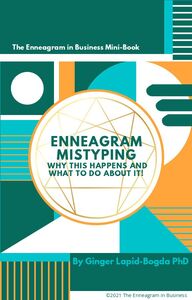
Return to flip book view
ENNEAGRAMMISTYPING WHY THIS HAPPENS ANDWHAT TO DO ABOUT IT!By Ginger Lapid-Bogda PhDThe Enneagram in Business Mini-Book©2021 The Enneagram in Business
Belief systemsPeople get mistyped for many reasons...Poor teachingOver-reliance on testsOver-reliance on specific books, blogs andpodcastsLooking for type in the wrong placesEnneagram complexitiesHuman complexitiesTyping too quicklyLearning issuesPsychological issues WHY DO PEOPLE GET MISTYPED?
-Ginger Lapid-Bogda PhD"The single most challengingaspect of teaching theEnneagram is to assist othersin discovering their Enneagramtype in an accurate andrespectful way"
POOR TEACHINGInsufficient Enneagram knowledge Over-complicating of system and typesOver-simplifying system and typesTeaching through stereotypesUsing inaccurate type examples Not having own type accurately identifiedTeaching only one subtype of the type as if that's thewhole typeOver-lecturing without visuals, interaction orcompelling storiesTeaching type through only one of the 3 Centers – forexample, over-reliance on the mind, the gut or theheartOver-directive teaching: telling people their typeUnder-guiding teaching: providing little direction orfeedback, relying primarily on self-typing Teacher's type bias showing in teaching Reason One
OVER-RELIANCE ON TESTSTests are, at best, only 65-70% accurateTeachers who rely solely on tests may not know theEnneagram well enough to help others clarify testaccuracyTests don't teach the other 8 types for comparisonPeople taking tests often believe the results because itis a testMost tests test better for certain types than othersTaking multiple tests, which often give differentresults, confusing test-takers Note: sole reliance on tests is the key issue Reason Two
Over-reliance on specific books,blogs, podcasts, andinformation from the internetNo "vetting" for accuracy on social media platformsTendency to rely on one book, one podcast, etc. forinformation provides limited perspectiveLimited dialogue about accuracy of informationContain a great deal of speculative information, oftenpresented as factAnyone can initiate blogs, post-casts on social media,whether they are trained in the system and types Reason Three
Enneagram complexitiesType, subtype, wings, arrows, fixations and holy ideas,passions and virtues, self-mastery level, Horneviangroupings, harmonic groupings, and moreToo much of the system complexities taught too earlyand become confusing, not clarifyingSystem complexities taught incorrectlyTeachers not understanding subtypes and subtype-typeconfusionsTeachers not experienced enough to know when andhow to introduce these different complex elements Reason Four
Human overlaysType, subtype, wings, arrows, fixations and holy ideas,passions and virtues, self-mastery level, Horneviangroupings, harmonic groupings, and morePersonal trauma, especially early traumaGenderCultureCountryFamily, particularly if a dominant parentContextual factors: for example, if someone hasextreme current stress or is in a caregiver role or... Reason Five
Looking for type in the wrongplacesFocusing on behaviors and not on motivation or drivePaying attention to “events” (things that occur onoccasion) rather than patterns of thinking, feeling andbehavingNot reflecting on yourself and on your patterns overtime (your lifetime!)Looking for an “expert” to tell you your typeNot accepting the shadow aspects of your type Reason Six
Typing too quicklyLanding too quickly on a type without exploringalternative typesBelieving someone else who tells you your typeOver-identifying with someone else who has their typeaccurately identified but is not the same type as you Reason Seven
Learning issuesSelectively listening or processing information abouttypesFocusing on only one or just a few aspects of a typerather than taking in/understanding the whole of thetypeNot being able to process complexity or paradoxesinherent in the typesJumping around from type to type so as to never settleand exploreLack of being able to be still and focus on true patternsof response (head, heart, somatic)Information overload; too much input with insufficientself-reflectionReason Eight
Psychological issuesNot being open or willing to explore feedback or ideasthat contradict the type you think you areWanting to be (or not be) a certain typeNot wanting to find your type for a variety of reasonsBeing one type feels limiting Not liking the type you areAvoiding self-reflection for a variety of reasonsHaving a self-image that matches another type and notyour own type, again for a variety of reasonsNot wanting to deal with something about yourselfthat accurate type identification would reveal Reason Nine
Belief systemsNot believing people have only one type Believing you can change typesThinking that typing is and should be easy and quick,when it is notBelieving that someone or something else is better atdetermining your type than you are yourself Reason Ten
What you can do to minimize mistypingPoor teachingBecome more educated by multiple, greatteachersOver-reliance on testsDon't use tests or use excellent supplementalmaterialOver-reliance on specific books, blogs andpodcastsGo to the best books, best podcasts etc.; bestisn't always the most followers or purchasesLooking for type in the wrong placesFocus on motivation, the why and not thewhat!Enneagram complexitiesFocus on type first, then subtypes and thenother elements of the system only as needed
Human overlaysExplore current conditions surrounding theperson being typedTyping too quicklyAsk yourself: What is the hurry?Learning and/or psychological issuesWhen you find them or sense them, increaseyour sensitivity and patience with the processBelief systemsAcknowledge and explore belief systems thatare obstacles to typing "The Enneagram is a sacred system, one that haspassed through centuries and generations, evolvingover time and offering greater and greater clarityabout ourselves, others, processes and consciousnessat an individual and a collective level."-Ginger Lapid-Bogda PhD
ABOUT THE ENNEAGRAM IN BUSINESSEstablished in 2004 by Ginger Lapid-Bogda PhD, The Enneagram inBusiness offers excellent quality, state-of the-art products and services.Our vision is to help elevate consciousness globally using the Enneagramintegrated with other innovative approaches; our mission is to provide anabundance of Enneagram-based resources for use around the world.These include the following:» Eight Enneagram books, including several best sellers» Full-color Enneagram training tools, in hard copy and virtual formats» Enneagram certification programs for consultants, trainers, and coaches» Premier leadership development and team development offerings» Training, coaching and consulting services, both virtual and in-person» A comprehensive, interactive online Enneagram Learning Portal (ELP)» A global network of over 70 top-quality Enneagram professionals (EIBN)ENNEAGRAM BOOKS by Ginger-Lapid-Bogda PhDBringing Out the Best in Yourself at WorkWhat Type of Leader Are You?Bringing Out the Best in Everyone You CoachThe Enneagram Development GuideConsulting with the EnneagramThe Enneagram Coloring BookThe Art of TypingThe Art of the Enneagram (co-authored with Russell Tres Bogda)TheEnneagramInBusiness.com | EnneagramLearningPortal.cominfo@TheEnneagramInBusiness.com | 510.570.2971